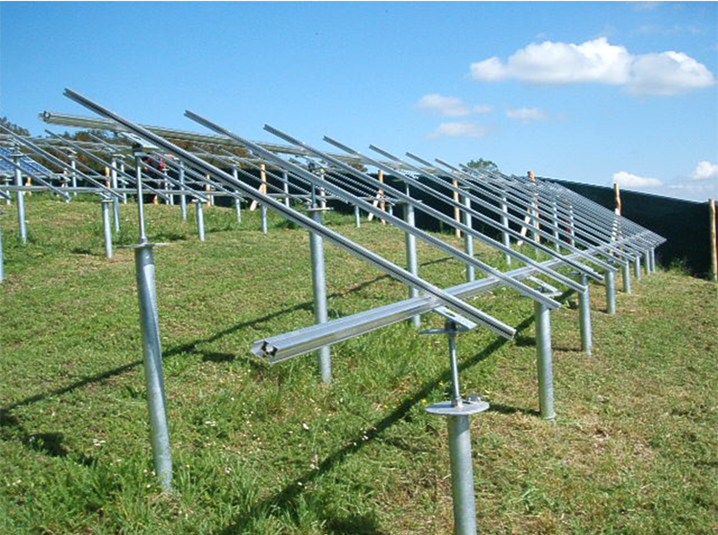-
2103 호실 322호 싱강 원 로드,하이창구,샤먼 푸젠,중국

What Is a Solar Mounting System for Solar Power Plants?
Solar panels are generally installed on metal structures called 마운팅 시스템 (also known as “racks” or “frames”). Each type of mounting system differs in cost, material characteristics, and ease of installation. Understanding these differences is essential when designing or investing in a solar power plant.
Table of Contents
Material Types of Mounting Systems
1. Stainless Steel Mounting Systems
Features:
- 우수 durability and corrosion resistance; suitable for coastal or high-salinity areas.
- High strength, but heavy—less efficient for transport and installation.
- Higher cost compared to other materials.
- Difficult to process on-site—requires pre-drilled holes.
- Not recyclable—incurs additional disposal costs.
2. Steel Mounting Systems
Features:
- Requires surface treatments like galvanizing or ZAM coating to prevent rust.
- Cost-effective compared to stainless steel.
- Offers high strength but is heavy and less flexible during installation.
- Processed areas (e.g., holes or cuts) may rust if not treated.
- Like stainless steel, non-recyclable—results in disposal costs.
Related product:
➡️ C – Steel Ground Mount – Screw Pile Foundation
3. Aluminum Mounting Systems
Features:
- Lightweight and corrosion-resistant due to anodized surface treatment.
- Generally more affordable than stainless or steel types.
- Slightly lower structural strength, but optimized design can improve performance.
- Easy to transport and install due to lower weight.
- Fully recyclable—lower removal and disposal costs.
Recommended system:
➡️ 알루미늄 그라운드 마운트 - 나사 파일 파운데이션

Types of Mounting Foundations
1. Concrete Foundations
(1) Block Foundation
- Blocks are partially or fully embedded into the ground.
- Offers good stability and pull-out strength.
- Installation cost is higher if embedding is required; placing blocks directly on the surface is possible with careful calculation.
- Not suitable for roof installations with weight limits.
🔗 Concrete Block Foundation Details
(2) Strip Foundation
- A row of concrete blocks connected together.
- Higher strength and stability than single blocks.
- Requires on-site casting—more labor-intensive and costly.
(3) Slab Foundation
- All blocks are fully connected forming a unified slab.
- Delivers the highest stability, but also the highest cost.
- Common in building construction, less so in solar-only projects.
2. Pile Foundations
(1) Pipe Pile Foundation
- Cost-effective; used in early solar power plants.
- Simple design—low pull-out resistance.
- Susceptible to wind damage; not compliant with updated safety standards like JIS8955 (2017).
(2) General Screw Piles
- Popular for ground-mounted systems.
- Requires pile-driving equipment; relatively easy to install.
- Strong pull-out resistance—ground strength should be N-value ≥ 3.
- Not suitable for soft soils (e.g., agricultural land).
(3) Wide-Blade Screw Piles
- 기능 larger spiral blades for greater resistance.
- Ideal for soft ground such as clay or farmland.
(4) C-Shaped Steel Piles
- Simple to install; lower cost than spiral piles.
- Decent strength, but weaker vertical pull resistance due to push-in structure.
🔗 C – Steel Ground Mount – Concrete Foundation

Optimal Tilt Angle for Solar Panel Installation
The optimal tilt angle varies by location and conditions:
- Japan average: 30°
- Okinawa: ~20° (closer to the equator)
- Hokkaido: ~45° (further from equator)
Other factors to consider:
- High wind regions (e.g., Kyushu): install at 10°–15° to reduce wind load.
- Snowy areas (e.g., Northern regions): steeper tilt to allow snow to slide off.
- Installing inverters (PCS) beneath panels? A small tilt angle may reduce clearance—impacting maintenance access.
Key Considerations for Mounting Height
Mounting height should be calculated considering:
- Maximum snow depth: panels must stay above snowline.
- Inverter or cable space under panels.
- Vegetation shading: low height may cause shadows from tall grass.
Conclusion
Choosing the right solar mounting system involves balancing cost, strength, material characteristics, and ground conditions. Whether you’re designing a solar project or evaluating a ready-made system, selecting the right combination of mounting frame and foundation is crucial for long-term reliability and efficiency.
If you’re unsure which system best suits your investment strategy, our team at Firstsolar is ready to assist. Contact us for expert design support and product selection advice.
Explore related solutions:








